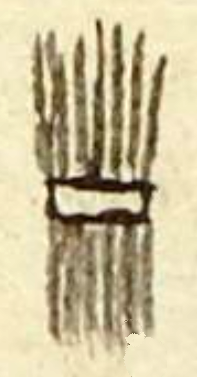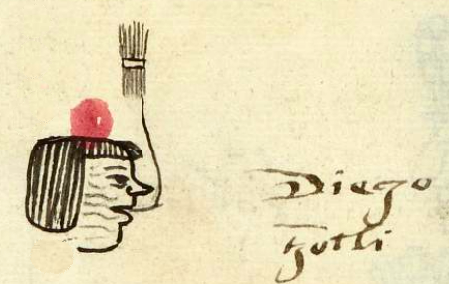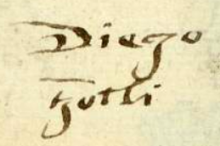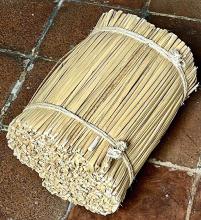Tzontli (MH631r)
This black-line drawing of the simplex glyph/notation for the personal name Tzontli ("400") is attested here as a man's name. The glyph shows a vertical bundle of sticks (or perhaps hairs), tied together at about the middle. This is a standard notation for the number four hundred (tzontli), typically found on codices where items of tributes in large numbers would be counted.
Stephanie Wood
A glyph for a tzontli can also involve a large lock of hair or even a tree. Four hundred, of course, is a vigesimal quantity, and the Nahuas had a vigesimal (root of 20) numerical system. A gloss on another example of tzontli (a case of 10 tzontli, or 4,000) refers to the items as "ramitos" (little branches). Likewise, a century ago, 400 small pieces of firewood were bundled in what was called a tzontle, a Nahuatl loan in Spanish. (See: Paul Carpenter Standley, Trees and Shrubs of Mexico - Part 1, 1926, 806.) This may support the reading that this numeration called a tzontli could have a visual association with branches or trees. Some signs for tzontli do look like the laurel or pine branches (acxoyatl) that were part of religious rituals. Nigel Davies (Human Sacrifice, 1981, 218), in fact, called a tzontli sign a "fir tree." Zelia Nuttall (in a volume of anthropological papers called Boas Anniversary Volume, published by Berthold Laufer in 1906, 296) refers to the bundles of 400 as containing either "sticks" or "hair." Some of the tzontli glyphs across this collection, such as the example here, do look like upright bundles of sticks that are bound around the middle. A binding like the one on this glyph above also appears in the Matrícula de Huexotzinco in a glyph for Tzompan, below.
Another common visual associated with the word tzontli involves large locks of hair or even strings of hair from the head. "Hair" is often the translation for tzontli into English. This word for hair and the word for 400 would therefore serve as homonyms. Similarly, speaking of 400 tzontles, four hundred corn cobs (Calixta Guiteras Holmes, Perils of the Soul, 1961, 47), is another case where the tzontli is simply a numeration and does not reflect upon the object being counted. So, the conclusion is that a sign for 400, like all of them, whether branches, sticks, or hair, will have the role of a phonogram.
Stephanie Wood
Diego
tzōtli
Diego Tzontli
Stephanie Wood
1560
Jeff Haskett-Wood
números, nombres de hombres, palos atados
This bundle of what appear to be reeds of the type used for making petates (woven mats, probably of a small size, in this case) also looks to be a bundle that could include four hundred of something–if not literally, figuratively. Hence, we are including it here as a comparison for the glyph tzontli (400). The bundle was found in an exhibit, “Tlatelolco <> Kreuzberg,” in the former Colegio de Santa Cruz Tlatelolco, in the building of Relaciones Exteriores, CDMX. Curator, Emil Becerril. Photo by S. Wood, 2 May 2025.

tzon(tli), hair, head, the number 400, https://nahuatl.wired-humanities.org/content/tzontli
Cuatrocientos
Stephanie Wood
Matrícula de Huexotzinco, folio 631r, World Digital Library, https://www.loc.gov/resource/gdcwdl.wdl_15282/?sp=344&st=image.
This manuscript is hosted by the Library of Congress and the World Digital Library; used here with the Creative Commons, “Attribution-NonCommercial-ShareAlike 3.0 License” (CC-BY-NC-SAq 3.0).








